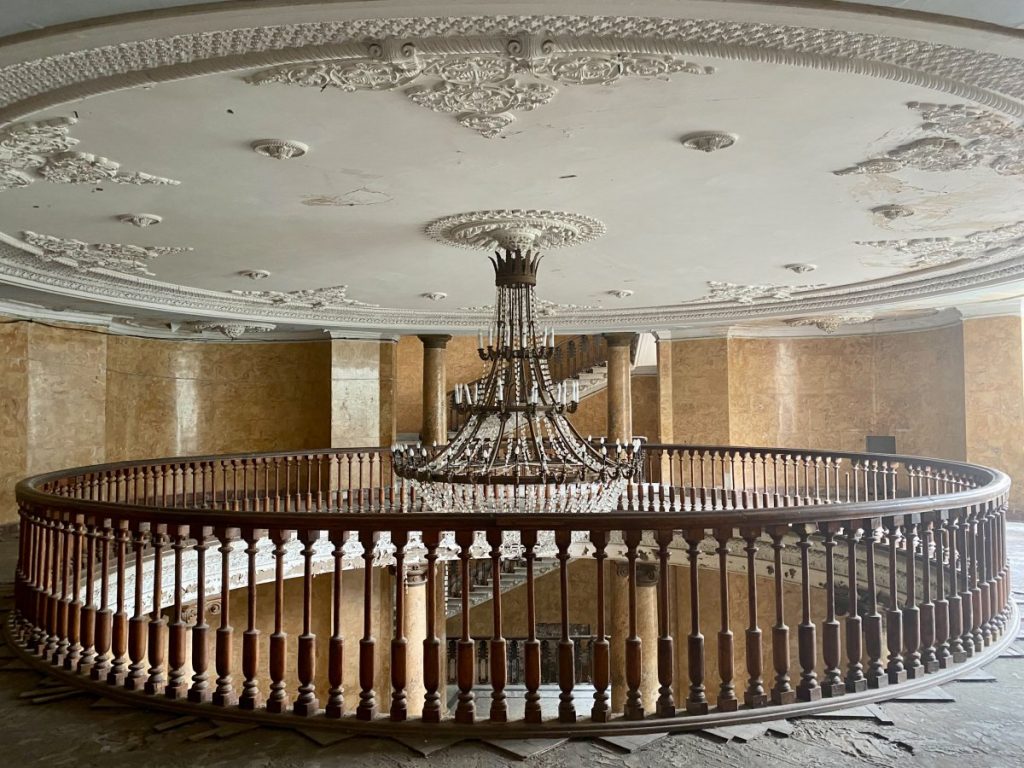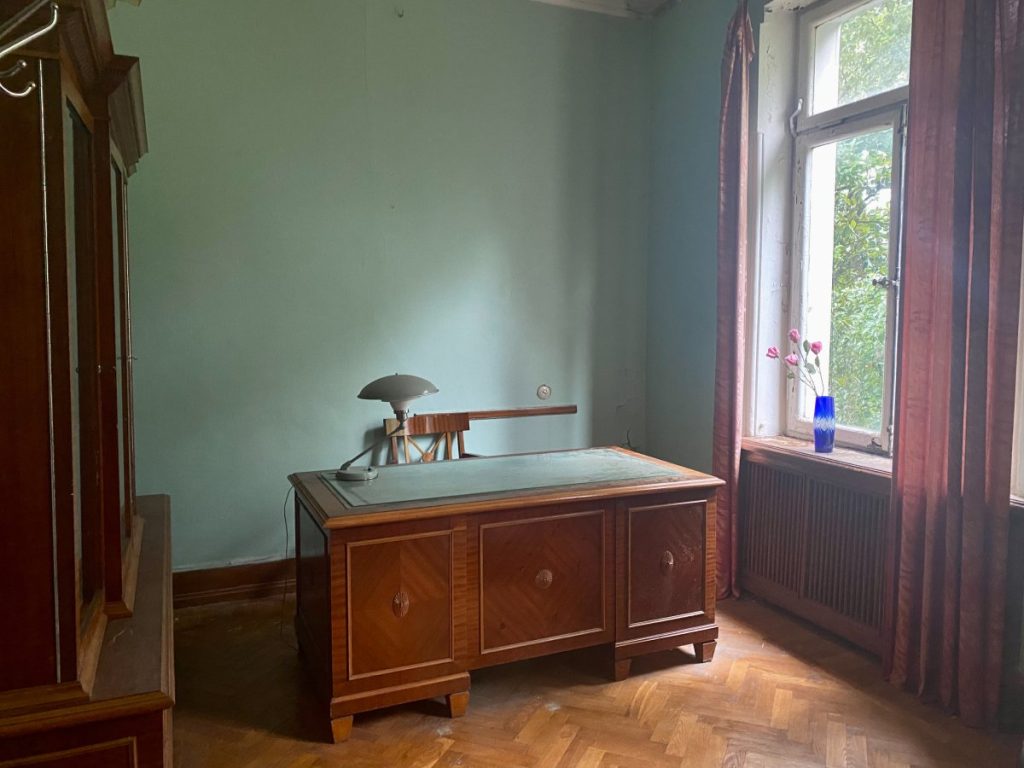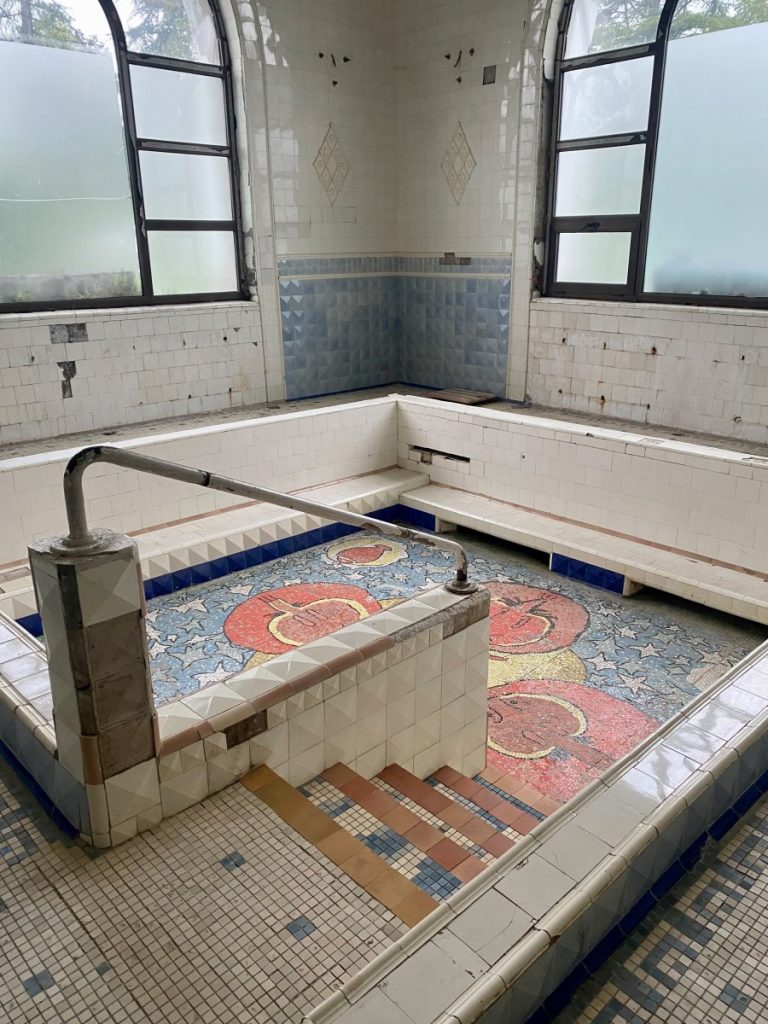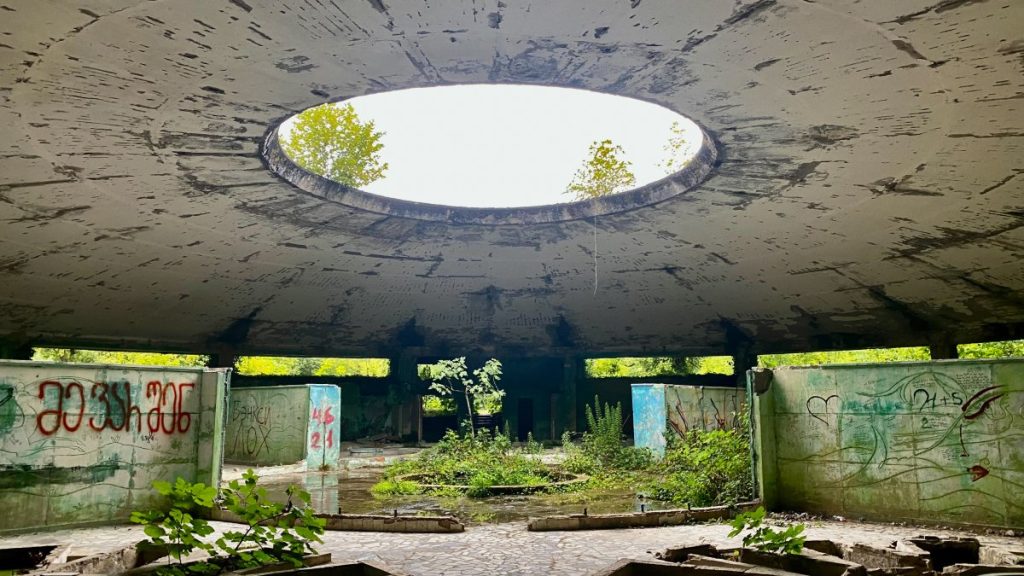
Exploring Tskaltubo: A Soviet Ghost Town of Abandoned Sanatoriums
Time stands still in Tskaltubo, where the once thriving Soviet spa and resort town has started to slowly be reclaimed by nature. This, however, has led this picturesque Georgian town to become a prominent destination for urban explorers and dark tourism enthusiasts.
In this guide, you will find everything you need to know about visiting the most famous abandoned Sanatoriums of Tskaltubo.
Where is Tskaltubo Located?
Tskaltubo is located in the western part of Georgia, in the Imereti region. It’s situated approximately 15 kilometers west of the city of Kutaisi, “Georgia’s historic city” as locals call it.
A Little Bit of History

Early Days
Tskaltubo’s history dates back to ancient times. The “Waters of Immortality” in Tskaltubo were probably known already in the 7th-9th centuries when the oldest historical records are dated.
These springs were believed to have medicinal and curative properties, and they attracted people seeking relief from various illnesses
During the Russian Empire
In the 19th century, during the period of Imperial Russia, Tskaltubo started gaining fame as a spa town. The Russian imperial authorities recognized the potential of the mineral waters and began to develop the area as a health resort. Elegant bathhouses, hotels, and sanatoriums were constructed to accommodate visitors seeking treatment and relaxation.
The Soviet Days
It was not until the Soviet era that Tskaltubo’s transformation into a major spa and resort town concluded.
In the early 20th century, it became a favored destination for Soviet citizens, including party officials and workers, who came for rest and recuperation. Workers were sent there free of charge or with a generous subsidy from the government.
Fun fact: Families were not allowed to stay in the same room, as the use of the Sanatoriums was meant to be healing, and not vacation. It was not unusual for couples to be sent in different Sanatoriums!
The town’s infrastructure expanded significantly during this time, with the construction of large sanatoriums and wellness centers.
During World War II, Tskaltubo served as a military hospital for wounded soldiers. Its sanatoriums and resort facilities were repurposed for medical care during the war.
Post Soviet Era
Following the dissolution of the Soviet Union, Tskaltubo faced economic challenges, and its prominence as a spa destination declined. Many of the once-grand sanatoriums fell into disrepair.
In recent years, there has been renewed interest in Tskaltubo’s potential as a tourist destination. Efforts have been made to restore some of the historic buildings and promote the town as a cultural and wellness destination.
Today, Tskaltubo is gradually regaining its status as a spa and wellness destination, with visitors coming to enjoy its thermal mineral waters and explore its historical architecture. The town’s history as a spa retreat, combined with its Soviet-era legacy, adds to its unique character and charm.
Do people live in the Sanatoriums?
During the conflict between Georgia and Abkhazia after the dissolution of the Soviet Union, around 8000 people decided to flee their homes and find shelter in the abandoned Sanatoriums.
Many people had their families there, and the new generations grew up in Tskaltubo. Families are still living there, in horrible conditions and in absolute poverty.
When the plans to revitalize Tskaltubo were announced, it was promised that the families who lived there would be relocated to new (and better) homes.
While this was partly achieved, many people still call the Sanatoriums home. Even in the buildings that were sold to investors, not all families were able to get to new homes.
Is Tskaltubo Safe to Visit?
Tskaltubo is, in general, a safe place to visit. However, that does not mean that you should not be careful.
One of the first things that has to come to your mind when planning a trip is insurance.
Safetywing’s Nomad Insurance is one of the best options available out there. With a maximum coverage of 365 days, they are a great option whether you are a Nomad or not! They offer very low rates, but excellent coverage and immediate support (in a few minutes!). The best part? Nomad Insurance can be purchased even if you have left your home country already.
Lastly, they also cover extreme sports, something that can come in very handy if you are an adventurous soul.
As you might know, the Sanatoriums have been abandoned for decades, and not all are stable. Furthermore, some of them have been bought by investors. Those are not always protected by a guard or fence, and you might be able to enter inside.
However, this can be considered trespassing and may get you in trouble. You are always entering at your own risk.
You should always examine a building or room before getting inside. Also, the people who live inside may not always welcome foreigners entering their homes, so try to be respectful of their space.
Don’t forget to bring hard shoes, as broken glasses and other items can be scattered around.
How to Get to Tskaltubo
Assuming that you start your trip to Tskaltubo from Kutaisi, here are a few transportation options you might want to consider:
- By Marshrutka:
You can catch a marshrutka at Kutaisi’s central bus station. The trip typically takes around 30 minutes. Make sure to always check the departure schedule and fares directly at the station.
- The first marshrutka option available is number 30, which departs from the Red Bridge every 15 minutes (8:00-19:00).
- Alternatively, you can take marshrutka number 34, which leaves from Kutaisi Central Bus Station every hour (9:00-18:00).
- By Taxi
- For me, this is the most convenient way of getting from Kutaisi to Tskaltubo. I suggest using Bolt, as the fare will always be fixed. The trip will last around 20 minutes and set you back at about 15 GEL. However, Bolt might be difficult to use on ther way back, as not all taxi drivers there use the app. If you take a regular taxi, make sure to negotiate the price beforehand.
- By Car:
- If you have your own car, everything becomes a lot easier. The two cities are about 20km apart, and the road is excellent.
Which Sanatoriums You Should Not Miss in Tskaltubo
Tskaltubo consists of 22 Sanatoriums. However, it is not possible to visit all of them, and not all are worth visiting. As I pointed above, some of them have been bought by investorsand are protected by a guard or fence, so getting inside can be impossible.
We’ll now be looking at the ones that you should not miss during your day trip. I believe that this is the most efficient order to visit so that you can make the most of your trip!
Sanatorium Imereti


Sanatorium Imereti was constructed in 1963 accoarding to the imperial Stalinist style. At its peak, it could accomondate more than 300 people! This one was recently bought by investors to be renovated and turned into a hotel, and a guard was put in place.
However, he was kind enough to let us in. Before doing so, he used Google Translate to tell us something quite haunting. “To see the conditions that these people live in will break your heart”. He couldn’t be more right. The families who live there have yet to be relocated, while the building is in horrible condition.
The Sanatorium has a mysterious aura around it, and seeing the residents adds a lot of food for thought. I recommend asking the guard for permission before going in to avoid any unnecessary trouble. It’s worth a try.
Sanatorium Metalurgi

Sanatorium Metalurgi stands as a fine example of Stalinist architecture. It was constructed to host the workers of the nearby metal mines, as their jobs mandated a lot of time to rest.
While certain parts of it lay in ruins and abandonment, it’s generally in decent shape and remains inhabited by people. There are plenty of rooms to explore and things to see. My favorite one would be the chandelier on the last floor.
It was undoubtedly my favorite among all the sanatoriums in Tskaltubo. I could easily spend hours inside, trying to explore every single corner and imagine how it might have used to look before.
Is There a Crazy Lady in Metalurgi?


You might have come across the story online about a “crazy lady” who demands cash to let you inside the building. This is somewhat true. Indeed, there is an elderly lady who requests 5 GEL per person for entry and a “guided tour” (not like one you would imagine).
There has been a small outrage online due to this, with many people calling out to skip Metalurgi. While I can understand the argument, I disagree with it.
The people living in the Sanatorium are refugees who have faced marginalization and live in dire poverty. I believe that 5 GEL, which is less than 2 dollars, is no crazy amount and will unquestionably contribute to improving their lives.
At this point, I’d like to share a personal story. On the day of our visit, it started raining heavily, and we couldn’t find shelter. Suddenly, we heard a voice from the Sanatorium. It was the lady inviting us to her apartment. She warmly welcomed us, prepared coffee, and insisted we stay until the rain had stopped, ensuring we were dry and ready to continue
Despite their hardships, these people treat you with nothing but kindness. Still thinking that 5 GEL (that, again, will improve their lives) is too much?
Sanatorium Medea

Medea is one of the most famous Sanatoriums in Tskaltubo and should definitely be on the top of your list. It is about 15 minutes walk from Metalurgi. It was constructed in the early 60’s, in the Stalinist style.
The sanatorium is notable for its architecture, which includes impressive columns and a distinctive design that reflects the architectural style of the time. The alley with the collums was for sure my personal favorite. This part is actually so beautiful, that a newly married couple was there to take their wedding photos.


Medea features multiple floors with various rooms for guests to explore, making it a popular attraction for those interested in history and architecture.
A few families still live in the Sanatorium, so explore freely but always carefully. Sanatorium Medea stands as a testament to the spa town’s rich past and continues to attract visitors interested in its unique history and architectural beauty.
Tskaltubo spa resort


Tskaltubo Spa Resort is a fascinating case. It is one of the sanatoriums that were bought by investors and was turned into a hotel. However, it was only partially renovated, with the other part now serving as a museum.
The hotel is doing tours upon request (priced at 25 GEL per person as of August 2023). You can head to the reception at any time and ask them to do a tour for you. If they don’t fully understand, tell them you want to see the museum. But what is it there to see?
The tour starts at a remarkably well-preserved amphitheater and then moves to a former Soviet café, which now displays maps, books, and old Soviet machines. I found it very interesting and took my time to examine every single artifact.
Later on, you’ll find yourselves in Joseph Stalin’s personal office! The Soviet leader visited Tskaltubo several times, and various areas were designated for his exclusive use. Inside the building, you’ll have the chance to view his office, bedroom, and bathroom, which is a surreal reminder that not too long ago, one of the world’s most influential figures worked there.


Finally, you’ll head to the gardens and see a plant that Yuri Gagarin, the first person ever to be launched into space, planted.
While the tour may seem a bit pricier than expected, and the guide might not provide an extensive amount of information, I still believe it’s a worthwhile experience, particularly if you are interested in Soviet history.
Bathhouse N6


This place is one of the few spas still up and running and was renamed “Spring 6” after the renovations. If you want to combine your day of exploring with a spa retreat, there couldn’t be a better place!
However, the spa is not the reason this building is known for. Neither are the artworks of Stalin greeting locals that are carved on the entrance walls.
But the real attraction here is the famous “Bath of Stalin,” a pool exclusively designed for the Soviet leader. It’s not used as a pool anymore but serves as a small museum.
Some people have debated whether you can visit it, with some saying it’s only open for press trips. However, we asked at the spa entrance, and they kindly let us in. The bath itself is in good shape, and, to be honest, I was pretty fascinated by its design and mosaics. I recommend giving it a visit or trying to.
Bathhouse N8

This marked the final destination of our journey. The bathhouse resembles a UFO (It reminded me of the UFO bridge in Bratislava), but it now stands deserted, left to decay through the passage of time. There are no guards or fences in place.
Right outside, you’ll find a sign that states, “Entrance is strongly prohibited, life-threatening”.
Indeed, the bathhouse is in a state of disrepair. Broken bottles and parts of the wall are scattered around. It might not be the safest place to explore, but we took a quick look inside.
Safety should always be your number one priority. That being said, While the building has a cool shape and a post-apocalyptic vibe inside, I wonder if it’s worth the risk of spending more than a few minutes there.
Final Thoughts
Tskaltubo stands as remarkable proof of both the rich history of Georgia and the power of nature to take back what belongs to it.
Wandering around and exploring the abandoned Sanatoriums arose feelings I am not sure I’ve felt before. While I had an amazing time there, I was thinking a lot about the people that still have to live in inhumane conditions there.
It’s a punch in the stomach, but an experience worth living. In the end, let’s appreciate the luck of enjoying a decent standard of living.




